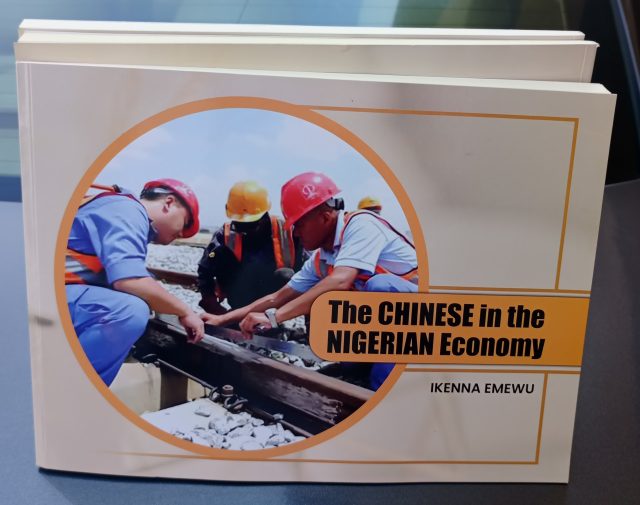The Chinese in the Nigerian Economy
Book Review
Title – The Chinese in the Nigerian Economy
Author – Ikenna Emewu
Publisher – Afri-China Media Centre Ltd.
Date of publication – December 2023
ISBN – 978-978-783-171-7
Topic of focus – Economy
Pagination – 130
Layout – landscape (A4)
Chapters – 7
Preamble – China’s desire to invest in other worlds is hot, unpretentious, and voracious. Investors from this world’s largest manufacturing country spread out in almost all
countries, and do not exclude Nigeria which has been one of the spots within their investment focus.
The 2023 World Population Review (worldpopulationreview.com) on the FDI (inward and outward) standing of the world countries listed China as second to the USA. However, with Hong Kong as the third, if counted together with Mainland China, then China is the highest. This trend has been sustained since at least 2014.
Already, since 2014, “China has remained the world’s largest investor in Africa in terms of total capital. They invested more than $72 billion in the continent from 2014 to 2018, according to the Brookings Institute. Those investments created more than
137,000 jobs across 259 projects.”
Such figures even from a US-based agency can disprove the notions that China uses Africa as an experimenting ground for enslaving loans, commodity dumping, and export of poor quality goods only. Whereas China is a single country
Africa owes the most, China is also by pole the largest investor in Africa, Nigeria inclusive. And Nigeria is at the top of the table.
This new book is possibly the latest release in the Nigerian market. This work is a product of knowledge with rich content delivered in simple, flowing journalistic language that makes for easy reading and understanding.
The book is segmented into seven main chapters, apart from the preliminary sections including the Introduction, Acknowledgment, Dedication, and Foreword, which was written by the Chinese Consul General, Ms. Yan Yuqing.
The content is derived from a broad spectrum of information sources, including interviews, research, participation, and visits. Some facts of the book are drawn from investigation and long-term relationships and interactions with the sources.
It is a book that aims to fill the information gap that exists in Nigeria about Chinese investments and contributions to the Nigerian local economy. The extent of the presence of the Chinese in the Nigerian economy has made them a major topic of discussion in our everyday lives. Unfortunately, most of our discussions are based on hearsay and unverified conclusions while none of us made efforts to find out what exactly is the true position of things.
Just a few days after this book was out, the author said read on a WhatsApp chat group he belongs to about a video that circulated widely on social media. It was a video of a chain of trucks on the Obudu-Vandeikya Road in the Cross River-Benue axis of Nigeria. Without any link with the video deriving either from the picture or the comment of the clip recorder, someone attached a comment to the video that it was “illegal Chinese exports every week.” Funny enough, many viewers believed it without asking how the person came to that conclusion. At a closer look and examination, the caption was based on unverified sentiments.
Such positions that have become commonplace in Nigeria are what the book aims to factually address.
Chapter 1 is on China’s Preferred Investment Market and addresses the perception of Nigerians about China, comparative values, and the quality of local Chinese goods and services. It also looked at the various segments of sub-sectors of the economy where the Chinese investors are active players in the automobile market; smartphone market; construction sector; ICT hardware, and other important issues.
Chapter 2 is on how Chinese interest and presence in Nigeria moved from trade to local investment in manufacturing with the various policy issues around them at the local and diplomatic stages. It analyzed the views of experts in the field, particularly diplomats from the Nigerian and Chinese sides, economists, and investors, including Nigerian investors, and their perceptions about the Chinese.
Chapter 3 tackled the persistent issue of negativity, to discern what is factual and what is not. It is an important discourse with a broad view and historical perspectives about the flops and failings of the Nigerian economy, especially the failed industrialisation policies since 1962 to goal is to determine whether China or its activities in Nigeria. It also looked at the other factors that contribute to the problems of our manufacturing or real sector up to the present. The topic helps to channel our attention to the necessary actions to get things right.
The chapter is on economic diplomacy between Nigeria and China since 1972 when the two were established. It is about the past and present efforts of the two countries to influence each other’s economies using diplomacy. The chapter helps us understand the important issues regarding debts, loans, debt trap claims, the influences in our infrastructure sector, and how Chinese players in the sector have fared in Nigeria in the past years.
Chapter 5 is so important and on a topic that deserves the most attention, which is labour issues and friction between Chinese employers and Nigerian workers. According to reliable sources, Chinese investors employ over 200,000 Nigerians. We looked at the preponderance of labour frictions, workers’ rights, the causes, what efforts are put in place to resolve them, enforcement lapses, and culture shocks involved. Even the reported cases of the incidents were looked at and even beyond Nigeria to other African countries. It also proffers solutions to the issues and how to make them right.
Chapter 6 is on the ways some of the companies have been doing things right, especially by helping to deepen the expertise and human capital base of Nigerian workers with new and advanced skills acquisition.
Chapter 7 zeroes in on specific Chinese companies, their worth, and contributions to the Nigerian economy in tangible terms.





